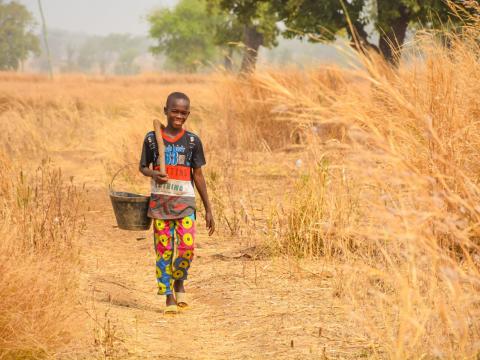The Termite King

In the quiet savannah of the Talensi District in the Upper East Region of Ghana, it is sunrise. The cock crows twice to tell the time; it is 6am. It crows a couple more times and out comes the “termite king”. With a bucket dangling playfully on his left arm, 12-year-old Bismark heads to their backyard to harvest termites.
Within minutes, he returns with two containers and walks majestically towards the hen coup. He is met with jubilation; mother hen and her chicks run towards him and the others follow as he begins to spread termites on the floor. It’s a feast for the fowls Bismark's mother is rearing and he takes delight in completing his only chore for the morning before getting ready for school.
A few years ago, this would have been a different story. Bismark would have had to journey at least 5 kilometers into the bushes to harvest termites.
The land in Talensi was mostly rocky and bare. Farmers had taken to bush burning to prepare their land for farming because the manpower required to clear the land was expensive. Since most people farmed close to their homes, there were hardly any trees or bushes left standing. It only rained four months in a year so the land was prepared in the dry season and left bare in anticipation of the rain to start planting.
The only trees and bushes available were in the very rocky parts where nobody wanted to farm. Since termites thrive in moist places where there are bushes or trees, children like Bismark had to travel at least twice a day to harvest them. Harvesters first have to go and place several containers filled with dried cow dune and millet stock in a moist part of the bushes, place a stone on it to prevent it from tipping over and leave it for the termites to grow. They later go back to collect harvest to feed the fowls.
The rising cost of commercial poultry feed is a major constraint to indigenous poultry production in these rural project communities. As a result, farmers have traditionally harvested termites free from the bush as a source of protein feed for chickens and chicks. This is mostly a chore for children, and the tiresome journey leaves them too tired for school and in some cases at the mercy of snakes.
In 2015, World Vision introduced the Farmer-Managed Natural Regeneration (FMNR) Project in the community with the support of Computershare and funding from Australia Aid. This trained farmers to prune trees and bushes to protect the soil, restore degraded land and allow trees and bushes to grow, since this helps retain water and nourish the soil instead of the usual practice of burning.
Bismark’s mother happened to have trained as one of the lead farmers for her community, and her adoption of the practice has brought her great gains. Besides increasing her farm yield and making enough income to begin rearing pigs and sheep as well as invest in a porridge business to give her children the life she dreams of, Bismark's mother enjoys that her son doesn’t have to struggle to complete his favorite house chore.
“I enjoy harvesting the termites because when I feed the fowls, they will grow big and my mother can sell them to pay for my school fees. We easily get the termites because they have stopped burning the bushes”, says a cheerful Bismark.
A majority of smallholder farmers in the Talensi District in the Upper East Region of Ghana give termites to their poultry as supplementary feed, but the quantities available have reduced over the years due to rampant perennial bushfires and environmental degradation. The World Vision Ghana and World Vision Australia Collaborative Farmer-Managed Natural Regeneration (FMNR) Project, being implemented in the district since 2009, strengthened community management of bushfires leading to drastic reduction of bushfires in project communities. Now, termites have returned to the area and are easily available near homesteads for farmers to trap to feed their chickens and other domestic birds. The practice has boosted indigenous poultry production as a key livelihood activity for poor rural farm households.